Agricultural shows, accompanied by displays of new inventions, various entertainments and food stalls, have been a popular part of community life from the early years of European settlement in South Australia. The South Australian Agricultural Society, formed in 1839, held its first produce and livestock exhibition in a marquee in Botanic Park in 1844. This exhibition featured John Ridley’s reaping machine, invented and manufactured in the Adelaide suburb of Hindmarsh. The show of 1845 included the first exhibition of South Australian wine.
The First Exhibition Building
The temporary show facilities in Botanic Park soon proved inadequate for the growing number of products, producers and visitors. In May 1859 the amalgamated committees of the Harmonic, Agricultural and Horticultural Societies petitioned parliament for a permanent exhibition building and showgrounds. The societies also wanted to use the building throughout the year for exhibitions and concerts.
Parliament agreed and provision was made for a building and grounds on the Police Paddock below the Royal Adelaide Hospital and adjoining the Botanic Gardens. The first Exhibition Building was completed in time for the South Australian Agricultural and Horticultural Show commencing 29 February 1860. The large, simple structure was designed by Colonial Architect Edward Angus Hamilton and built by McMullen, Young & Scanlan. The exterior featured semi-circular headed windows and paired pilasters. Wide verandas catered for outdoor exhibits. The South Australian Register of 24 February noted its situation ‘in the midst of the old forest trees which are now to be seen in no other part of the metropolis’.
The Jubilee Exhibition Scheme
The idea for a much grander building surfaced in 1883 with proposals for an international exhibition to celebrate the Golden Jubilee of the colony. The Bray Government passed an Exhibition Act authorising the exhibition, but allocated no funds. The initiative collapsed the following year when a new government repealed the Act.
Almost two years later, Adelaide brewer, parliamentarian and philanthropist Sir Edwin Thomas Smith revived these proposals at a meeting of influential and sympathetic Adelaidians held in the Town Hall on 31 July 1885. He advocated the holding of an Adelaide Jubilee International Exhibition modelled on the Great Exhibition of 1851, staged at the Crystal Palace in Hyde Park, London. Adelaide’s celebration of 50 years of official European settlement in South Australia would showcase produce and manufactured goods from British colonies and some selected countries.
A committee was appointed to plan the exhibition and gain the necessary government support. Prominent South Australian businessmen, landowners and parliamentarians, including Sir Samuel Davenport, John Cox Bray MP, John Howard Angas, Thomas Hardy, Alfred Muller Simpson, John Duncan, Henry Rymill, Theo Hack and William Bundey (Adelaide’s mayor), volunteered their services. Smith remained a driving force.
An ambitious scheme
The committee’s ambitious scheme involved constructing an exhibition complex on the western side of Frome Road, extending from North Terrace to the River Torrens, with the sloping site divided by a retaining wall. The main exhibition building and its western and eastern annexes were located above the wall and bordered by North Terrace. The northern annexe, various halls and the showgrounds were situated below. The two levels were connected by an impressive flight of steps. To enable easy transport of livestock and exhibits the grounds were linked to the Adelaide Railway Station and yards via a railway line under City Bridge (King William) Road.
Funding was to be generated through a government allocation of £32 000 for the main building, with a few ‘gentlemen’ acting as guarantors for other costs not met by entrance fees. The committee anticipated that visitor numbers and the collection of fees would be enhanced by the anticipated completion of the intercolonial railway and the stopover of passengers from ocean steamers en route to eastern Australia.
The committee aimed to have all construction completed ready for an exhibition launch in June 1887, to coincide with the Golden Jubilee of Queen Victoria. Although this date was one year after the fiftieth anniversary of official European settlement of South Australia, it followed the 1886 Indian and Colonial Exhibition in London, facilitating the collection of displays from other colonies.
Royal Agricultural and Horticultural Society backing was secured through the proposed transfer of its activities from the old exhibition site to the new building and grounds once the Jubilee Exhibition was over. The Botanic Gardens authority and the Zoological Society also came on board knowing that if it succeeded they would take over the old exhibition grounds.
Continued opposition
In spite of this support and the influential figures behind the comprehensive plan, the government persisted with its opposition. Crucial additional pressure came from the working people of Adelaide. Newspaper reports on the intended exhibition coincided with unemployment and destitution among many of the colony’s labourers and skilled artisans. A meeting of the unemployed in the Reform League Hall in September 1885 called for government support for the exhibition proposal, which would generate much needed employment. Workers also demanded a public meeting with attendance by all local parliamentarians.
A crowded public meeting was duly held at the Adelaide Town Hall on 2 October 1885.The mayor presided and key proponents of the scheme attended. Smith argued that rather than being an expensive luxury that South Australia could ill afford, an exhibition would provide a boost to the economy. He cited the success of exhibitions already held in Sydney and Melbourne. The meeting criticised the government veto of the 1883 plan and urged Parliament to support Smith’s proposal. A deputation led by the mayor then met with the Attorney-General, but still faced resistance.
However, broad community support for an exhibition designed to stimulate economic activity and employment, as well as provide entertainment, eventually won the day. It overcame opposition from the government and from some country areas generated by firms such as G & R Wills and Harris Scarfe & Co., who saw the scheme as ‘a waste of public money’. By the end of November 1885 parliament had agreed to allocate the desired land for the exhibition and no more than £32 000 for an exhibition building. The business community gave guarantees of additional funds.
The Jubilee Exhibition Building and Grounds
The organising committee moved quickly to get the scheme going. Sir Edwin Smith was elected executive chairman of the Adelaide Jubilee International Exhibition of the Arts, Agriculture and Manufactures to be held between June 1887 and June 1888. HRH the Prince of Wales agreed to be patron of the exhibition. The government also established a commission, chaired by the governor, to generate support and participation from around the globe.
A competition was held to select the design for the main building. The winning entry was submitted by EA Scott, a young man articled to the firm of Bayer & Withall. However, this design was too expensive. The committee then chose a design by Withall & Wells, who were later appointed architects to the project. The builder was W Rogers.
The Exhibition Building’s large foundation stone of Kapunda marble was laid by Governor Sir William Robinson on 21 June 1886. The trowel, featuring a blade of gold from the Echunga goldfields and a handle of gold, silver and malachite, was designed and manufactured by AL Brunkhurst of Rundle Street and donated by H Steiner. A cavity in the stone contained a copy of one of the original handbills issued in London before the colony was founded. Three brass bands played at the ceremony attended by an estimated 12 000 people from all walks of life.
Retaining walls (dividing the site into three rather than two levels as originally intended) were built at the beginning of the project in 1886. Other construction above and below the walls then proceeded apace.
The main two-storey Jubilee Exhibition Building was built in a formal classical Beaux Arts style with stucco decorations. Semi-circular headed windows on each floor were separated by pilasters and an imposing dome crowned the centre. A look-out tower provided a panoramic view of Adelaide. The three centre doors facing North Terrace were protected by a portico of four columns. A wide promenade resting on arches surrounded three sides of the building. Two fountains played in front of the building. At the rear, flights of steps connected it to the terraces and exhibition grounds below: a few steps remain north of the present Napier Building. The rear view of the building, with its steps and decorations, was as imposing as the front. The terraces and grounds were laid out by Dr Richard Schomburgk, director of Adelaide Botanic Garden, and Conservator of Forests John Ednie Brown.
The main hall of the Exhibition Building was 150ft (145.7m) long, 86ft (26.2m) wide and 56ft (17m) high with a gallery running around three sides. While it could seat 6000 people, during the exhibition it was divided into five display courts. The central ground floor housed wine and refreshment bars, and a kitchen and dining room. The western annexe housed eight courts, while the eastern annexe bordering Frome Road included a concert hall accommodating 800 people. The northern annexe in the grounds below contained the agricultural hall. Other rear structures included halls for armaments, flour and milling, machinery and agricultural implements; a kiosk; and several ‘trophies’ erected by particular firms.
The scheme as envisaged by Smith was completed with the construction of the Jubilee Exhibition Railway, linking Adelaide Railway Station with the exhibition site. The railway tunnel under King William Road was lined with bluestone.
The Adelaide Jubilee International Exhibition of the Arts, Agriculture and Manufactures
Adelaide came alive in the days immediately preceding the opening of the exhibition. Crowds of country and intercolonial visitors thronged the streets. Special jubilee trains brought people from New South Wales and Victoria. There was great demand for accommodation in in Adelaide’s hotels and lodging-houses.
Special guests also began arriving. Chinese Commissioner-General Wong Yung Ho and Consul-General ‘U Tsing’ arrived on 18 June. They were met at the Adelaide Railway Station by Premier Thomas Playford and representatives of Adelaide’s Chinese community, including Way Lee, ‘Geeg Vning’, Chung Wing and Yung War.
The official launch of the exhibition on 21 June 1887 was preceded by a march through the city by cavalry, infantry, artillery and marines from several ships. Governor Sir William Robinson opened the door to the newly completed Jubilee Exhibition Building with a specially made gold and bejewelled master key, housed in a ruby velvet case lined with white satin and bearing a gold plate engraved with Adelaide’s coat of arms.
Up to 8000 people gathered in the hall for the opening ceremony. A large choir was arranged on each side of the organ. Women choristers wore white; those seated on one side wore a pink bow at the throat and those on the other, a blue bow. The University of Adelaide’s professor of music, Joshua Ives, conducted the orchestra. The choir sang the ‘Song of Australia’, composed in South Australia by Carolyn Carleton and Carl Linger, and an Exhibition Cantata written for the occasion. At the close of the ceremony a telegram to Queen Victoria was read to the crowd and then transmitted by Superintendent of Telegraphs Charles Todd from ‘an instrument erected in front of the platform’.
Exhibits came from all of the Australasian colonies except Western Australia. A wide range of countries were also represented – Great Britain, Germany, Japan, France, United States, Sweden, Denmark, Austria, Belgium, Portugal, Canada, Spain, Italy, Turkey, Belgium, Switzerland, Malta, Fiji, China, Seychelles and the Sultan of Jahore (now a Malaysian state). Entries were judged by 200 jurors under the supervision of Dr Edward Rennie of the University of Adelaide with prizes awarded at a ceremony on 30 November 1887.
The exhibition proved hugely popular. By its close on 7 January 1888, 789 672 people had attended, more than twice Adelaide’s population. Edwin Smith’s optimism proved warranted, with the city benefiting from sales and jobs, and the enterprise ending in credit.
Later use of the building and grounds
Following the exhibition, the buildings and grounds hosted many shows and events. A dinner for delegates to the Adelaide convention discussing federation of the Australian colonies was held in the main hall in 1897. Night shows became the rage from 1900 with the establishment of a general electricity supply in Adelaide. Mayoral balls, public meetings and organisational gatherings all took advantage of the facilities. Dame Nellie Melba and Clara Butt sang to packed audiences in the main hall. Annual agricultural shows continued to be held in the grounds and annexes until 1925, when the Royal Agricultural and Horticultural Society moved to its current site at Wayville. A regular exhibition was also held in the Exhibition Building until the land was transferred to the University of Adelaide in 1934.
The Jubilee Exhibition Building on North Terrace was used by various government departments and the South Australian School of Art (from 1890–91) until 1962, when the neglected building was demolished and replaced by the University of Adelaide’s Napier Building, underground car park and plaza with a reflecting pool (now removed). The railway line was filled in when the Royal Adelaide Show moved to Wayville.
One of the Exhibition Building’s fountains is outside Adelaide Arcade in Rundle Mall and the other is in the Creswell Gardens next to Adelaide Oval.


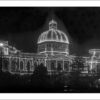


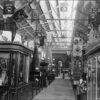
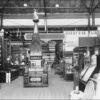
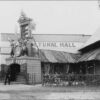
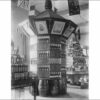
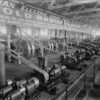
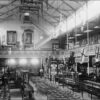
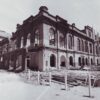
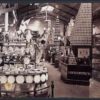
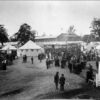
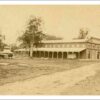
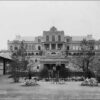
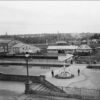
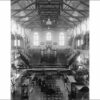
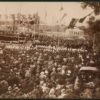
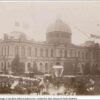
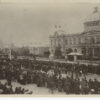
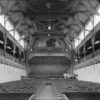
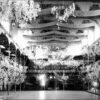
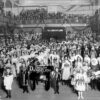

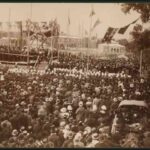
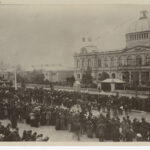
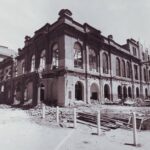
Comments